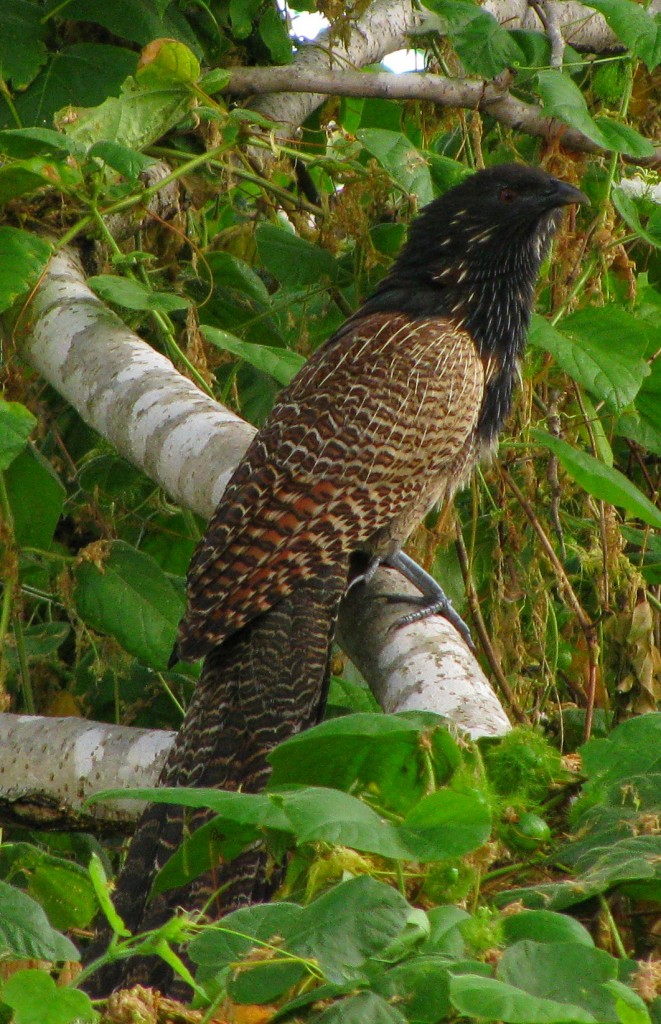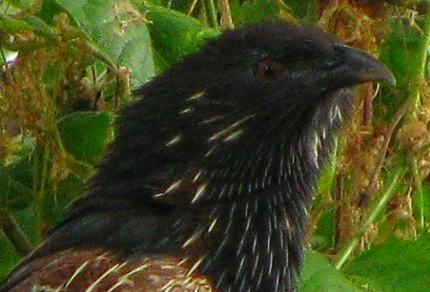
Pheasant Coucal, Centropus phasianinus, in Breeding Plumage, Townsville, Queensland (© Magi Nams)
I saw my first pheasant coucal in January in Townsville, running along the top of a wooden, back-yard fence under an orange-flowering poinciana tree, its long tail like a wedding train behind it. Soon after that, I learned to connect a deep and descending ‘COOP-coop-coop-coop-coop’ vocalization with this superficially pheasant-like bird. Since then, I’ve heard or seen at least a hundred coucals, which are more closely related to cuckoos than pheasants and which always leave me with two impressions. These birds are extremely attractive, and they are extremely peculiar.
Pheasant coucals belong to the avian family Centropodidae, of which the world is blessed with 24 species, although Australia is home to only one of these.1 All were once thought to be ‘aberrant cuckoos’, as my field guide states, but differ from cuckoos quite markedly in that they construct their own nests and care for their own young; thus they are now recognized as a taxonomic grouping unto themselves.1
That Australia’s pheasant coucal is handsome, there is no doubt. Its red eyes gleam, its richly-barred plumage is a tapestry in muted tones, its black head (in breeding plumage; in non-breeding plumage, the head is streaked brown and blonde) presents a striking contrast to its wings, back, tail, and underparts.
But this bird’s a skulker, hiding behind shields of branches, clinging clumsily but effectively to thin saplings or clumps of grass stalks, dropping quicky into cover when approached. I’ve seen coucals dust-bathe on gravel roads and then lurch awkwardly into roadside vegetation. I’ve watched them land heavily on perches that appear too thin and delicate to support their weight, yet somehow do. Sometimes they clamber up perches like a man with loose coat tails pulling himself hand over hand up a pole. Other times, they flop around in dense vegetation like a drunken fool.
Pheasant coucals feed on the ground, where they rob bird nests of eggs and young or hunt insects, crustaceans, frogs, and small mammals.2 Understandably, they’re unpopular with other birds and are frequently mobbed by them.2 They build their own nests in sugarcane, grass clumps, pandanus or bushes, and draw nest materials together over the saucer-shaped nest to offer it protection.2 During their breeding season of October to April,2 the air fairly resounds with their deep-voiced calls.
I have attempted again and again to photograph these wary, skulking birds with no success until yesterday morning, when one flew up from the ground into a tree as I cycled past. For all of 30 seconds, it remained in the open. In that time, I braked, retrieved my camera from my pack, stepped a few feet closer, and snapped a shot. It was the only one I got, the coucal suddenly embracing its skittish character and ducking behind a screen of branches. Fortunately, the shot was a good one.
Reference:
1. Graham Pizzey and Frank Knight. The Field Guide to the Birds of Australia. 1997. Angus & Robertson, Sydney, p. 534.
2. Ibid, p. 298.



Wonderful pic of the Pheasant coucal- congrats on finally capturing him – quite stunning! Really enjoying the scientific detail of your writing as well – found you from the Nature Blog Network, we’re two traveling wildlife biologists new to the blog – happy to follow your adventures 🙂
http://www.benandcarrietracks.blogspot.com
Thanks, Ben and Carrie. Glad you’re enjoying my posts. A year is too short a time for all the beauties and fascinating wildlife of Australia. Best wishes in your travels. – Magi